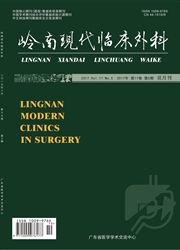

 中文摘要:
中文摘要:
目的分析前哨淋巴结(SLN)阳性原发乳腺癌患者腋窝非前哨淋巴结(NSLN)转移的预测因子。方法回顾性分析212例SLN阳性并接受腋窝淋巴结清扫术的患者资料。获取的SLN均按示踪剂浓度排序并测量浸润灶大小。对各种临床及病理组织学因素数据进行单因素分析,纳入单因素分析有意义(P〈0.05)的预测因素进行logistic多因素分析。结果多因素分析提示NSLN转移与SLN转移率(P〈0.001)、SLN阴性个数(P=0.02)、染色剂浓度最小SLN转移(P=0.02)、SLN最大转移灶大小(P〈0.001)有关。全部SLN转移者NSLN转移可能性较非全部SLN转移者大;随SLN阴性个数增加,NSLN转移率下降;染色剂浓度越大SLN转移机会越大,浓度最小SLN转移者较浓度最小SLN无转移者SLN,其NSLN转移几率更高;最大转移灶〉2 mm者出现NSLN转移可能性比SLN最大转移灶≤2 mm者大。结论 SLN转移率(P〈0.001)、SLN阴性个数(P=0.02)、染色剂浓度最小SLN转移(P=0.02)、SLN最大转移灶大小(P〈0.001)是NSLN转移的独立预测因子。
 英文摘要:
英文摘要:
Objective To investigate the predictable factors of metastasis in non sentinel lymph nodes(NSLN) in patients with prime breast cancer with positive sentinel lymph nodes(SLN).Methods Patients with primary breast cancer and positive sentinel lymph node(n=212) were included in this retrospective study.All patients had positive SLNs that had been ordered by the concentration of tracer,and were analyzed to determine factors that predicted additional positive axillary nodes. Pearson Chi-square or T-test were used for univariate analysis. Logistic regression was used for multivariate analysis..Results Of 212 breast cancer patients with positive sentinel lymph node ranked by the concentration of tracer, multivariate analysis revealed that NSLN was associated with the SLN metastases rate(P〈0.001), the number of negative SLN(P=0.02), metastases in the latest lymph node(P =0.02) and the size of SLN metastases(P 0.001) which independently predicted the NSLN metastases. Conclusion SLNs with higher concentration of tracer might have higher possibility of metastasis. Our study suggested that the SLN metastases rate, the number of negative SLN, metastases in the latest lymph node and the size of SLN metastases independently associated with NSLN metastasis.
 同期刊论文项目
同期刊论文项目
 同项目期刊论文
同项目期刊论文
 期刊信息
期刊信息
